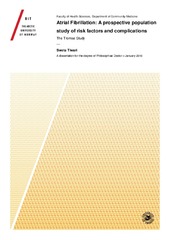Atrial Fibrillation: A prospective population study of risk factors and complications. The Tromsø Study
Permanent lenke
https://hdl.handle.net/10037/13346Åpne
thesis introduction and appendices (PDF)
Tiwari, S., Løchen, M.L., Jacobsen, B.K., Hopstock, L.A., Nyrnes, A., Njølstad, I., … Schirmer, H. (2016). CHA2DS2-VASc score, left atrial size and atrial fibrillation as stroke risk factors in the Tromsø Study. Also available in Open Heart, 3(2):e000439. (PDF)
Tiwari, S., Løchen, M.L., Jacobsen, B.K., Hopstock, L.A., Nyrnes, A., Njølstad, I., … Schirmer, H. (2017). Atrial fibrillation is associated with cognitive decline in stroke-free subjects: The Tromsø Study. Also available in European Journal of Neurology, 24, 1485-1492. (PDF)
Dato
2018-04-26Type
Doctoral thesisDoktorgradsavhandling
Forfatter
Tiwari, SwetaSammendrag
Background: Atrial Fibrillation (AF) is the most common arrhythmia associated with increased mortality and morbidity. It increases the lifetime risk of stroke and heart failure and affects one’s quality of life and cognition.
Objective: To investigate diastolic dysfunction as risk factor for AF and AF as a risk factor for stroke and cognitive decline.
Methods: Participants from the Tromsø Study were used as study sample. From the fourth survey (1994-95), 2406 participants who were free from AF, were followed until 2010 to examine the association between diastolic dysfunction, measured by echocardiography at baseline, and AF. From the same survey, 2844 participants free from stroke, were followed until 2012 to examine the association between AF and stroke, independently of other risk factors. From the fifth (2001) and sixth (2007-08) survey, 2491 participants with repeated cognitive screening were followed prospectively to examine AF as a risk factor for cognitive decline.
Main results: Enlarged left atria (LA) as a measure of diastolic dysfunction gave a fourfold increased risk of AF in both sexes, and adding measures of abnormal diastolic flow increased the predictive ability significantly. When enlarged LA size was combined with CHA2DS2-VASc score ≥1, participants had nine times increased odds of stroke regardless of AF status. In stroke free participants, AF was significantly associated with 40% larger cognitive decline as measured with the tapping test.
Conclusions: Diastolic dysfunction was found to be a risk factor for AF mainly through enlarged LA. Enlarged LA and CHA2DS2-VASc score >1was a strong predictor for stroke, regardless of AF status. Repeated cognitive screening measured with the tapping test found AF as a risk factor for cognitive decline. Our findings suggest closer clinical monitoring of patients with CHA2DS2-VASc score >1 and Holter monitoring in people with no known AF but with increased risk of stroke and cognitive decline.
Beskrivelse
Paper I is not available in Munin.
Paper I: Tiwari, S., Schirmer, H., Jacobsen, B.K., Hopstock, L.A., Nyrnes, A., Heggelund, G., … Løchen, M.L. (2015). Association between diastolic dysfunction and future atrial fibrillation in the Tromsø Study from 1994 to 2010. Available in Heart,101, 1302-1308.
Forlag
UiT The Arctic University of NorwayUiT Norges arktiske universitet
Serie
ISM skriftserie; 191Metadata
Vis full innførselSamlinger
- Doktorgradsavhandlinger (Helsefak) [770]
- ISM skriftserie [161]
Copyright 2018 The Author(s)
Følgende lisensfil er knyttet til denne innførselen:


 English
English norsk
norsk
